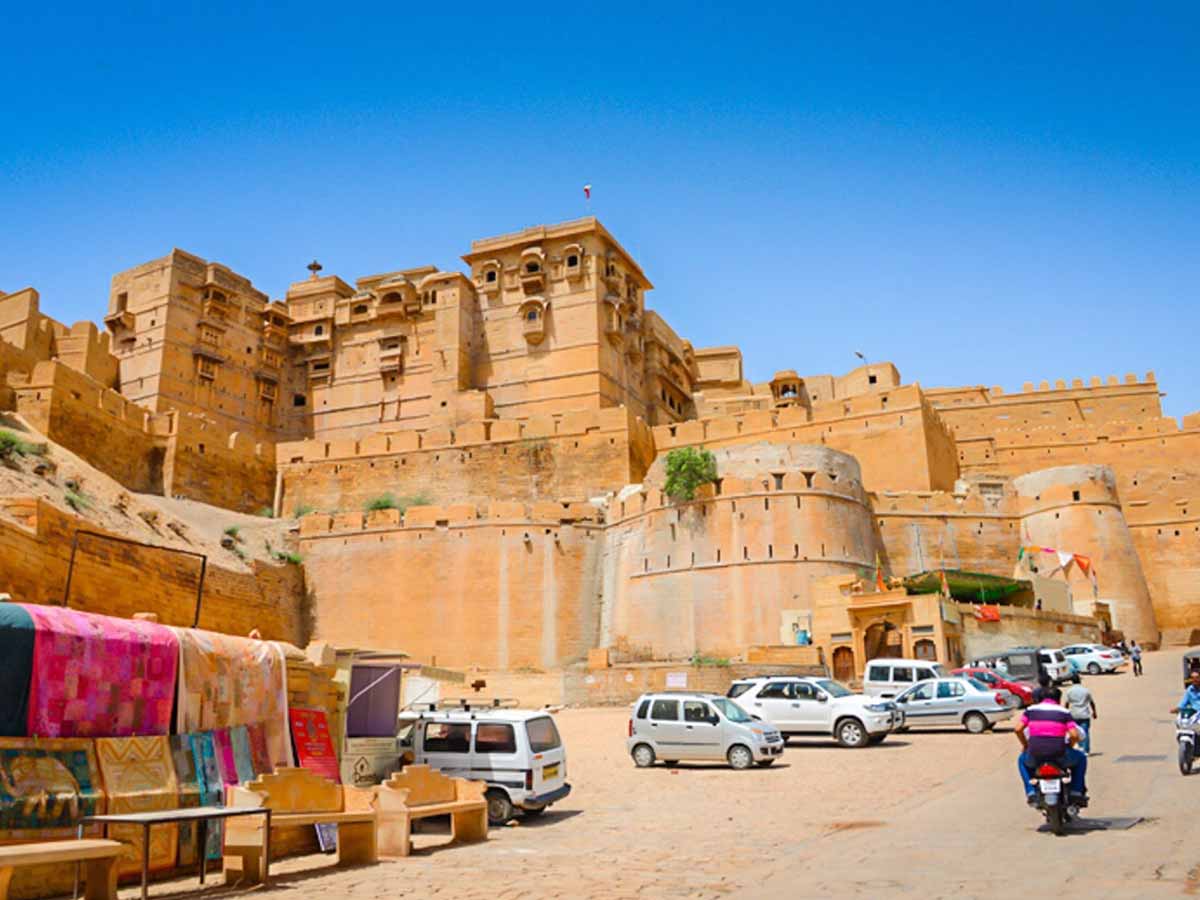The piece de resistance of the lively Thar desert is a magnificent structure built from yellow sandstone, called the Jaisalmer Fort. Perched atop the Trikuta Hill (triple peaked hill), this imposing fort seems to rise straight from the desert and its gleaming stone fade gives the impression of it being an extension of the magnificent Thar. The magic of this architectural marvel is best witnessed at sunset when the whole fort seems ablaze as it reflects the light from the setting sun, earning it a spot on the list of UNESCO World Heritage Sites. The fort is known for its elaborately carved structure called Raj Mahal, the residence of the erstwhile royal family and the beautiful Jain and Laxminath temples it is home to. The fort also piqued the interest of Oscar winning Indian filmmaker Satyajit Ray, who featured it in one of his films Sonar Quila or the Golden Fortress.
This imposing structure was built in 1156 AD by Rajput ruler, Jaisal, and was reinforced by subsequent rulers of Jaisalmer. The fort was the focus of a number of battles between the Bhatis, the Mughals of Delhi and the Rathores of Jodhpur and has four massive gateways.

History of Jaisalmer Fort Rajasthan
The fort is believed to have a rich history dating about 860 years back. For most of these years, the fort was actually the city of Jaisalmer. It was much later, in the 17th century, that people started settling on the outskirts of the fort's walls.
Built in 1156 AD, this is the second oldest fort in the history of Rajasthan. It was built by Raja Rawal Jaisal, a Bhatti Rajput king. Built on the Trikuta Hill along the Thar Desert, it was positioned strategically along the east-west caravan route that connected this part of the country, the entire Central and Middle-East Asia, with North Africa.
The fort walls are made from sandstone which gives it a gleaming golden look, especially during the day, which is why it is known as the Sonar Quila. Being a prominent part of the erstwhile trade route in India, the fort became the home to many traders and merchants who constructed Havelis, temples, shops, palaces, etc., inside the fort premises. Bazaars or markets were also set up to facilitate trading.
In about 1299 AD, Alauddin Khilji sieged the fort. The fort remained under the Delhi Sultanate for many years but was finally taken over by the local Bhatis. Between 1530 and 1552, the fort came under the attack of a local Afghan ruler, Amir Ali. However, Rawal Lunakaran won the war, and Amir Ali had to withdraw troops.
Later, in the sixteenth century, the fort was again attacked by Emperor Humayun. Consequently, Rawal Lunakarn’s daughter was wed to Akbar, and the control of the fort was passed on to the Mughals. The Mughal reign lasted till 1762, after which Maharawal Mulraj fought the Mughals and took control of the Jaisalmer Fort.
Due to a treaty with the East India Company, the fort continued to be in the control of the Rawal rulers during the British Raj. With new ports and maritime trade growth, the ancient trade route slowly lost significance. As a result, Jaisalmer’s importance as a trading juncture was also lost in the twentieth century. Jaisalmer Fort's history is eloquently expressed in the architectural supremacy of the fort.
Jaisalmer Fort is undoubtedly an architectural beauty. It is an eloquent depiction of Rajasthani architecture with a beautiful blend of local designs with Mughal styles.
Four beautifully carved entrances to the fort – Akshaya Pol, Ganesh Pol, Hawa Pol, and Suraj Pol. The Suraj Pol receives the city’s first rays of the sun. These gates were once guarded by soldiers and backed by cannons.
The fort is 460 meters long and 230 meters wide. The height of the hill on which the fort was constructed is 76 meters.
The fort’s design depicts circular bastions and double fortification walls, giving it an advantage during wars and battles. To facilitate easy movement of soldiers during battles, there’s a pathway separating the outer and the inner fortification walls. The other interesting feature is the pitching wall that ensures that the sandy soil of the hill is held in place.
Jaisalmer Fort architecture is characterized by the ornate umbrella-shaped cupolas or the chhatris. There are delicately carved screens that provide shade from the burning sun.
Jaisalmer tourism is one of the best known in the state of Rajasthan as it is full of hospitality. Jaysalmar (or Jaisalmer) is a nicknamed as ‘The Sun City’ and ‘The Golden City’ for it’s bright, hot days and golden colored sand. Alike other Rajasthani cities, Jaisalmer tour will take foreigners towards forts, and other architectural monuments and there are lots of Jaisalmer tourist places to visit in the winters.